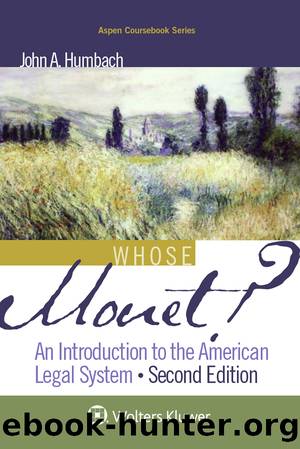Whose Monet? by John A. Humbach;

Author:John A. Humbach;
Language: eng
Format: epub
Publisher: Kluwer Law International
Published: 2016-08-15T00:00:00+00:00
Hart v. Massanari
266 F.3d 1155 (9th Cir. 2001)
* * *
KOZINSKI, Circuit Judge
Common law judges did not make law as we understand that concept; rather, they âfoundâ the law with the help of earlier cases that had considered similar matters. An opinion was evidence of what the law is, but it was not an independent source of law. See Theodore F.T. Plucknett, A Concise History of the Common Law 343-44 (5th ed. 1956).103 The law was seen as something that had an existence independent of what judges said: âa miraculous something made by nobodyâ¦and merely declared from time to time by the judges.â 2 John Austin, Lectures on Jurisprudence or the Philosophy of Positive Law 655 (4th ed. 1873) (emphasis omitted). Opinions were merely judgesâ efforts to ascertain the law, much like scientific experiments were efforts to ascertain natural laws. If an eighteenth-century judge believed that a prior case was wrongly decided, he could say that the prior judge had erred in his attempt to discern the law. See Bole v. Horton, 124 Eng. Rep. 1113, 1124 (C.P. 1673). Neither judges nor lawyers understood precedent to be binding in [a] strict sense.
* * *
[A]s late as the middle of the nineteenth century, an English judge might ignore decisions of the House of Lords, and the Exchequer and Queenâs Bench held different views on the same point as late as 1842. Common law judges looked to earlier cases only as examples of policy or practice, and a single case was generally not binding authority.
* * *
The idea that judges declared rather than made the law remained firmly entrenched in English jurisprudence until the early nineteenth century.â¦Blackstone, who wrote his Commentaries only two decades before the Constitutional Convention and was greatly respected and followed by the generation of the Framers, noted that âthe âlaw,â and the âopinion of the judgeâ are notâ¦one and the same thing; since it sometimes may happen that the judge may mistake the lawâ; in such cases, the precedent simply âwas not law.â 1 William Blackstone, Commentaries 70-71 (1765).
* * *
The modern concept of binding precedentâwhere a single opinion sets the course on a particular point of law and must be followed by courts at the same level and lower within a pyramidal judicial hierarchyâcame about only gradually over the nineteenth and early twentieth centuries. Lawyers began to believe that judges made, not found, the law. This coincided with monumental improvements in the collection and reporting of case authorities. As the concept of law changed and a more comprehensive reporting system began to take hold, it became possible for judicial decisions to serve as binding authority.
* * *
[Then Judge Kozinski described in some detail the law of precedent in the American federal courts. Ed.]
When ruling on a novel issue of law, [a federal court] will generally consider how other courts have ruled on the same issue. This consideration will not be limited to courts at the same or higher level, or even to courts within the same system of sovereignty.
Download
This site does not store any files on its server. We only index and link to content provided by other sites. Please contact the content providers to delete copyright contents if any and email us, we'll remove relevant links or contents immediately.
The Thirst by Nesbo Jo(6780)
Permanent Record by Edward Snowden(5706)
The Myth of the Strong Leader by Archie Brown(5390)
Spare by Prince Harry The Duke of Sussex(5026)
A Higher Loyalty: Truth, Lies, and Leadership by James Comey(4813)
Secrecy World by Jake Bernstein(4611)
Adulting by Kelly Williams Brown(4458)
The Borden Murders by Sarah Miller(4210)
Machine Learning at Scale with H2O by Gregory Keys | David Whiting(4029)
Killers of the Flower Moon by David Grann(3920)
American Kingpin by Nick Bilton(3731)
Fear by Bob Woodward(3608)
The Secret Barrister by The Secret Barrister(3587)
Future Crimes by Marc Goodman(3484)
The Last Girl by Nadia Murad(3414)
The House on Mango Street by Sandra Cisneros(3371)
Liar's Poker by Michael Lewis(3343)
The Social Psychology of Inequality by Unknown(2916)
Graduate Admissions Essays, Fourth Edition: Write Your Way into the Graduate School of Your Choice (Graduate Admissions Essays: Write Your Way Into the) by Asher Donald(2849)
